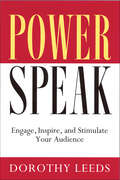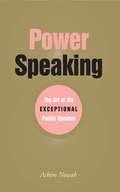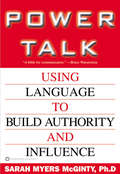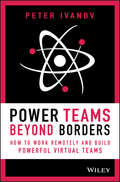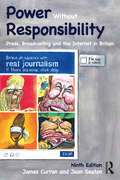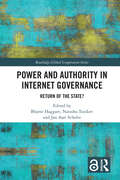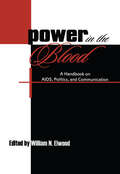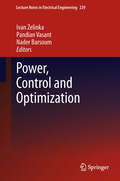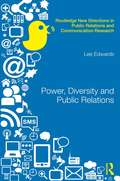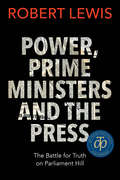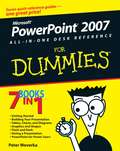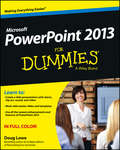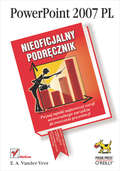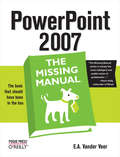- Table View
- List View
Power Speak: Engage, Inspire, and Stimulate Your Audience
by Dorothy LeedsWhat is the secret to being a captivating and credible speaker? Never be boring! If you are boring, people will not listen. The central message and focus of PowerSpeak is the importance of engaging, stimulating, and maintaining an audience's attention.This book focuses on the elements of speaking effectively from a design and a delivery perspective. Dorothy Leeds isolates these essential elements to assure that any speaker can gain and keep the audience's attention. She focuses on the trouble spots of any presentation and the six major faults speakers make.This book also includes tips on the following:•Breaking the fear barrier.•Ten steps that guarantee a complete presentation.•How to avoid weak, passive language and make humor your ally.•Voice and speech exercises.•How to handle the Q & A portion of a presentation.•How to develop your own style and project positive body language.•How to incorporate (or not incorporate) new technology into presentations.
Power Speaking: The Art of the Exceptional Public Speaker
by Achim NowakIntegrating key concepts and ideas about public speaking into a clear, step-by-step, transformational method, Power Speaking teaches emerging speakers how to grow the necessary skills and unleash their inner power. Divided into proficiency levels-mastering the basics, making the connection, and polishing the core-this guide allows speakers to conquer public speaking systematically. Readers start with the use of voice and body movements, then move on to learn the use of personal stories, intent listening, and positioning or reframing a topic.
Power Talk: Using Language to Build Authority and Influence
by Sarah Myers McgintyAs anyone whos ever tried to decipher their last investment account statement knows, the language of finance can sound foreign and intimidating. As clever as it is straightforward, and filled with quirky yet helpful tips, this dictionary of financial terms and acronyms is packed with hundreds of brief, plain-spoken definitions that will appeal to the novice and seasoned investor alike.
Power Teams Beyond Borders: How to Work Remotely and Build Powerful Virtual Teams
by Peter IvanovEmpower your virtual and remote teams with this comprehensive and timely new resource Power Teams Beyond Borders: How to Work Remotely and Build Powerful Virtual Teams shows readers how to unlock the potential of their remote and online teams. Full of actionable advice and concrete strategies, celebrated consultant and author Peter Ivanov offers virtual leaders practical guidance on how to create and sustain online engagement across multiple time zones and cultures. The book includes step-by-step advice on areas like: How to build trust and clarity without meeting in person How to establish structure in communications and avoid confusion How to make the most of your team members’ unique talents in a global setting How to use the technique of “over-communication” to ensure your team members remain fully informed Perfect for anyone who’s expected to lead in an online or virtual environment, Power Teams Beyond Borders also belongs on the bookshelves of everyone who hopes to deliver results in an environment that includes remote teamwork.
Power Up Your PowToon Studio Project
by Bruce GrahamWhether you are a beginner wanting to learn from a professional or a seasoned user looking for a refresher, this is the book for you.
Power Without Responsibility: Press, Broadcasting and the Internet in Britain
by James Curran Jean SeatonThis book attacks the conventional history of the press as a story of progress; offers a critical defence and history of public service broadcasting; provides a myth-busting account of the internet; a subtle account of the impact of social media and explores key debates about the role and politics of the media. It has become a standard book on media and other courses: but it has also gone beyond an academic audience to reach a wider public. Hailed as ‘a classic of media history and analysis’ by the Irish Times and a book that has ‘cracked the canon’ by the Times Higher, it has been translated into five languages. This edition contains six new chapters. These include the press and the remaking of Britain, the rise of the neo-liberal Establishment, the moral decline of journalism, the impact of social media and a history of attempts to reform the press. It contains new research on the relationship between programmes, institutions and society. It places key UK institutions in the wider context of international affairs and their impact. The book has been updated to take account of new developments like Brexit and the rise of Jeremy Corbyn and the shift in authority and legitimacy prompted by social media. It does this with a clear explanation of how policy can shape media outcomes.
Power Without Responsibility: Press, Broadcasting and the Internet in Britain
by James Curran Jean SeatonThis book attacks the conventional history of the press as a story of progress; offers a critical defence and history of public service broadcasting; provides a myth-busting account of the internet; gives a subtle account of the impact of social media; and explores key debates about the role and politics of the media.Power Without Responsibility has become a standard textbook on media and other courses, but it has also gone beyond an academic audience to reach a wider public. Hailed as a book that has ‘cracked the canon’ by the Times Higher Educational Supplement, it has been translated into five languages. In 2019, it was awarded the International Communication Association's Fellows Book Award. This ninth edition is based on a major overhaul of its content to take account of new developments (such as generative AI) and new scholarship in the field. It also contains a new chapter on the transformed opportunity for a reformed and buccaneering public service broadcasting in the face of automated misinformation and social division, locally, nationally and internationally.This trailblazing text is essential reading for all students and scholars interested in British media and contemporary media and society.
Power and Authority in Internet Governance: Return of the State? (ISSN)
by Jan Aart Scholte Blayne Haggart Natasha TusikovPower and Authority in Internet Governance investigates the hotly contested role of the state in today's digital society. The book asks: Is the state "back" in internet regulation? If so, what forms are state involvement taking, and with what consequences for the future?The volume includes case studies from across the world and addresses a wide range of issues regarding internet infrastructure, data and content. The book pushes the debate beyond a simplistic dichotomy between liberalism and authoritarianism in order to consider also greater state involvement based on values of democracy and human rights. Seeing internet governance as a complex arena where power is contested among diverse non-state and state actors across local, national, regional and global scales, the book offers a critical and nuanced discussion of how the internet is governed – and how it should be governed.Power and Authority in Internet Governance provides an important resource for researchers across international relations, global governance, science and technology studies and law as well as policymakers and analysts concerned with regulating the global internet.The Open Access version of this book, available at http://www.taylorfrancis.com, has been made available under a Creative Commons Attribution-Non Commercial-No Derivatives (CC-BY-ND) 4.0 license.
Power and Authority in Internet Governance: Return of the State? (Routledge Global Cooperation Series)
by Jan Aart Scholte Blayne Haggart Natasha TusikovPower and Authority in Internet Governance investigates the hotly contested role of the state in today's digital society. The book asks: Is the state "back" in internet regulation? If so, what forms are state involvement taking, and with what consequences for the future? The volume includes case studies from across the world and addresses a wide range of issues regarding internet infrastructure, data and content. The book pushes the debate beyond a simplistic dichotomy between liberalism and authoritarianism in order to consider also greater state involvement based on values of democracy and human rights. Seeing internet governance as a complex arena where power is contested among diverse non-state and state actors across local, national, regional and global scales, the book offers a critical and nuanced discussion of how the internet is governed – and how it should be governed. Power and Authority in Internet Governance provides an important resource for researchers across international relations, global governance, science and technology studies and law as well as policymakers and analysts concerned with regulating the global internet.
Power in Business Relationships: Dynamics, Strategies and Internationalisation (Routledge Focus on Business and Management)
by Dariusz Siemieniako Maciej Mitręga Hannu Makkonen Gregor PfajfarFocusing on the issue of power as the main building block of relationships between business buyers and sellers, this book explains the complex nature of power with its multidimensional and multi-directional character. As a complex construct, inter-firm power is treated as a matter of perception as well as in terms of total and relative power. The book analyses extensively the issue of power asymmetry with its dynamics and its consequences for business-to-business (B2B) relationships, particularly analyzing the dynamic mechanism of power. Various theoretical domains or research streams regarding managing an asymmetrical business relationship by the weaker partner are also examined. Based on the studies of other scholars as well as on the authors' own research, this book shows how weaker suppliers or buyers deal with high-power partners in business relationships and the approaches of more powerful parties to asymmetrical relationship development. Additionally, the book presents the specific nature of power in international B2B relationships, including its connection to culture and conflict, as well as how to handle power in managing export performance within international B2B relationships. It is written for scholars and students who are interested in academic research concerning B2B marketing and B2B relationship marketing domains, specifically those who are interested in literature dealing with supply chain management, key account management, relationship portfolio management, distribution channel management and the network approach.
Power in Megaproject Decision-making: A Governmentality Approach (ISSN)
by Thayaparan Gajendran Jessica Pooi SivaThis research-based book critically examines the complex interplay of power relations in decision-making in megaprojects. This book is tailored for academics, students, practitioners, clients, and policymakers and addresses a significant gap in understanding how formal and informal power influences decision-making. Through applying governmentality theory and narrative inquiry from thirty-nine interviews, this book presents over sixty-five detailed stories offering a series of real-life narratives that expose the diverse forms of power at play in megaprojects. The stories reveal how deviations from norms can significantly impact project outcomes. This book uncovers the complex web of power relations, institutional norms, and individual actions driving decisions.This book provides a framework illustrating four behavioural contexts, entrepreneurial, box-ticking, deception, and recklessness, as manifestations of megaproject decision-making, providing readers with a tool to understand and navigate the intricate power dynamics in megaprojects.Readers will benefit from practical insights and strategies for fostering conducive decision-making environments, tailoring interventions to promote constructive behaviours, and mitigating harmful actions. This book is a resource for anyone seeking to grasp the complexities of megaproject management in the context of power relations, shaping their decision-making leading to success.
Power in the Blood: A Handbook on Aids, Politics, and Communication (Routledge Communication Series)
by William N. ElwoodIn this single volume, William N. Elwood has gathered potent evidence of the impact that the HIV/AIDS epidemic has had on the world, its communities, and its inhabitants, and he addresses the role of communication in affecting the way in which people respond to AIDS. With a multidisciplinary group of contributors and topics ranging from political rhetoric to interpersonal discourse, Power in the Blood offers a multitude of ways in which to think about power, politics, HIV prevention, and people living with HIV. Readers will be able to use this information in class discussions, program designs, grant applications, and research, as well as in their own lives. With this volume, Elwood makes a thoroughly convincing argument that communication is the key to understanding, treating, and preventing AIDS, and he inspires further action toward the goal of ending the AIDS crisis.
Power of Family: An Experiential Approach to Family Treatment
by John Conway Gary Stauffer D. Maurie Lung Tony AlvarezThe authors invite you to explore the intentional use of interactive interventions as a primary methodology in family treatment. The activities they introduce into the therapy office provide an immediate context for witnessing how the family functions first-hand. In this manner, families reveal systems, structures, cognitive and emotional processes, strategies, communication styles, approaches to problem-solving, as well as other issues traditionally targeted in the process of family treatment. The intent is to provide an environment that allows family members to freely and genuinely demonstrate their strengths and limitations.
Power to the People: Use your voice, change the world
by Danny SriskandarajahDanny Sriskandarajah learned the value of citizenship at a young age as the child of Tamil migrants who moved from Sri Lanka to Australia. Arriving in the UK as the first Rhodes scholar from an Asian immigrant background, he has gone on to run a series of civil society organisations, and has become a leading voice in the third sector.POWER TO THE PEOPLE is his radical manifesto for change designed to inspire citizen action around the world. The book presents a blueprint for how we, as individuals, can make a difference through greater community engagement, and how we can deliver a society that works for the many and not the few. He speaks to voter apathy and a growing sense that elections no longer matter, with politicians and institutions too focused on short-term issues to grapple with complex global problems such as climate change, rising inequality, and digital disruption. Yet the book is also filled with inspiring real-life examples of citizen power in action, ranging from a volunteer-run repair café in Danny's local suburb to Avaaz's successful campaigns to tackle endemic corruption in Brazil.From public ownership of social media spaces to democratising share ownership, and from re-energising co-operatives to creating a people's chamber at the United Nations, this campaigning book has a clear mission to make us reclaim our power as citizens of the world.
Power to the People: Use your voice, change the world
by Danny SriskandarajahDanny Sriskandarajah learned the value of citizenship at a young age as the child of Tamil migrants who moved from Sri Lanka to Australia. Arriving in the UK as the first Rhodes scholar from an Asian immigrant background, he has gone on to run a series of civil society organisations, and has become a leading voice in the third sector.POWER TO THE PEOPLE is his radical manifesto for change designed to inspire citizen action around the world. The book presents a blueprint for how we, as individuals, can make a difference through greater community engagement, and how we can deliver a society that works for the many and not the few. He speaks to voter apathy and a growing sense that elections no longer matter, with politicians and institutions too focused on short-term issues to grapple with complex global problems such as climate change, rising inequality, and digital disruption. Yet the book is also filled with inspiring real-life examples of citizen power in action, ranging from a volunteer-run repair café in Danny's local suburb to Avaaz's successful campaigns to tackle endemic corruption in Brazil.From public ownership of social media spaces to democratising share ownership, and from re-energising co-operatives to creating a people's chamber at the United Nations, this campaigning book has a clear mission to make us reclaim our power as citizens of the world.
Power, Control and Optimization
by Nader Barsoum Pandian Vasant Ivan ZelinkaThe book consists of chapters based on selected papers of international conference "Power, Control and Optimization 2012", held in Las Vegas, USA. Readers can find interesting chapters discussing various topics from the field of power control, its distribution and related fields. Book discusses topics like energy consumption impacted by climate, mathematical modeling of the influence of thermal power plant on the aquatic environment, investigation of cost reduction in residential electricity bill using electric vehicle at peak times or allocation and size evaluation of distributed generation using ANN model and others. Chapter authors are to the best of our knowledge the originators or closely related to the originators of presented ideas and its applications. Hence, this book certainly is one of the few books discussing the benefit from intersection of those modern and fruitful scientific fields of research with very tight and deep impact on real life and industry. This book is devoted to the studies of common and related subjects in intensive research fields of power technologies. For these reasons, we believe that this book will be useful for scientists and engineers working in the above-mentioned fields of research and applications.
Power, Diversity and Public Relations (Routledge New Directions in PR & Communication Research)
by Lee EdwardsPower, Diversity and Public Relations addresses the lack of diversity in PR by revealing the ways in which power operates within the occupation to construct archetypal practitioner identities, occupational belonging and exclusion. It explores the ways in which the field is normatively constructed through discourse, and examines how the experiences of practitioners whose ethnicity and class differ from the ‘typical’ PR background, shape alternative understandings of the occupation and their place within it. The book applies theoretical perspectives ranging from Bourdieuvian and occupational sociology to postcolonial and critical race theory, to a variety of empirical data from the UK PR industry. Diversity emerges as a product of the dialectics between occupational structures, norms and practitioners’ reactions to those constraints; it follows that improving diversity is best understood as an exercise in democracy, where all practitioner voices are heard, valued, and encompass the potential for change. This insightful text will be essential reading for researchers and students in Public Relations, Communications, Media Studies, Promotional Industries, as well as all scholars interested in the sociology of race and work relations.
Power, Prime Ministers and the Press: The Battle for Truth on Parliament Hill
by Robert LewisAn intimate history of the journalists who covered Canadian history, and made some of their own. The history of the press gallery is rich in anecdotes about the people on Parliament Hill who have covered 23 prime ministers and 42 elections in the past 150 years. Mining the archives and his own interviews, Robert Lewis turns the spotlight on the watchers, including reporters who got too close to power and others who kept their distance. The Riel Rebellion, the Pacific Scandal, two world wars, the Depression, women's liberation, Quebec separatism, and terrorism are all part of the sweeping background to this lively account of how the news gets made, manipulated, and, sometimes mangled. Since Watergate, press gallery coverage has become more confrontational — a fact, Lewis argues, that fails Canadian democracy.
Power, Privilege and the Post: The Katherine Graham Story
by Carol FelsenthalKatharine Graham's story has all the elements of the phoenix rising from the ashes, and in Carol Felsenthal's unauthorized biography, Power, Privilege, and the Post, Graham's personal tragedies and triumphs are revealed. The homely and insecure daughter of the Jewish millionaire and owner of The Washington Post, Eugene Myer, Kay married the handsome, brilliant and power hungry Phillip Graham in 1940. By 1948 Kay's father had turned control of The Washington Post over to Phil, who spent the next decade amassing a media empire that included radio and TV stations. But, as Felsenthal shows, he mostly focused on building the reputation of the Post and positioning himself as a Washington power-player. Plagued by manic depression, Phil's behavior became more erratic and outlandish, and his downward spiral ended in 1963 when he took his own life. Surprising the newspaper industry, Kay Graham took control of the paper, beginning one of the most unprecedented careers in media history. Felsenthal weaves her exhaustive research into a perceptive portrayal of the Graham family and an expert dissection of the internal politics at the Post, and a portrait of one of a unique, tragic, and ultimately triumphant figure of twentieth-century America.
PowerPoint 2003 Personal Trainer
by Customguide IncPowerPoint is the world's most widely used presentation program, a favorite of educators, trainers, and, of course, those in business everywhere. Yet, every time Microsoft releases a new version of the program, they introduce another set of features---most of which you'll never understand or use. Even if you have experience with PowerPoint, you'll struggle to keep up with the improvements. If you're a beginner, you probably don't know where to start. Now, with PowerPoint 2003 Personal Trainer , beginners and experts alike can become black belts with this presentation program, quickly and easily. This fully illustrated book takes a modular approach to learning, allowing you to start with the fundamentals and work your way to advance topics through dozens of task-oriented lessons--at your own pace. The companion CD tutorial guides you through each lesson interactively. PowerPoint 2003 Personal Trainer includes sections on editing, formatting, drawing, working with word art, tables, organization charts, multimedia, other programs, the Internet, and how to optimize presentation delivery. Every chapter includes detailed diagrams and a review at the end to help you absorb and retain all you have learned. If you already use PowerPoint, you can dive right into those topics (and only those topics) that you need or want to learn. Unlike many consumer software tutorials that dumb down the material or present it in a confusing fashion, PowerPoint 2003 Personal Trainer is written in a non-technical and engaging style that you will find fun, easy, and most of all, clear and informative. You don't have to wade through tons of jargon and technical information to become proficient. Part of our new Personal Trainer Series, this book is based on content from CustomGuide ( http://www.customguide.com ), a leading provider of computer training materials. Founded by instructors who grew dissatisfied with the industry's dry course materials, CustomGuide offers courseware (for instructors and students), quick references, to software bulletins and e-learning courses that are fun, flexible, and easy to use.
PowerPoint 2007 All-in-One Desk Reference For Dummies
by Peter Weverka7 books in 1--your key to PowerPoint success!Your one-stop guide to perfect presentations with PowerPoint 2007Everybody uses PowerPoint, right? How can you make your presentations pop? Check this handy reference with its easy-to-use minibooks! Once you get going with all the cool new stuff in PowerPoint 2007, you find out how to jazz up your presentations with charts, transitions, photos, animation, and even some ultra-cool power-user tricks.Discover how toPlan and create a presentationUse speed techniquesHandle master slides and master stylesCustomize slides with themes and templatesMake diagrams and chartsCreate video slides
PowerPoint 2007 For Dummies
by Doug LoweNew and inexperienced PowerPoint users will discover how to use the latest enhancements to PowerPoint 2007 quickly and efficiently so that they can produce unique and informative presentations PowerPoint continues to be the world's most popular presentation software This updated For Dummies guide shows users different ways to create powerful and effective slideshow presentations that incorporate data from other applications in the form of charts, clip art, sound, and video Shares the key features of PowerPoint 2007 including creating and editing slides, working with hyperlinks and action buttons, and preparing presentations for the Web
PowerPoint 2007 For Dummies
by LoweNew and inexperienced PowerPoint users will discover how to use the latest enhancements to PowerPoint 2007 quickly and efficiently so that they can produce unique and informative presentationsPowerPoint continues to be the world's most popular presentation softwareThis updated For Dummies guide shows users different ways to create powerful and effective slideshow presentations that incorporate data from other applications in the form of charts, clip art, sound, and videoShares the key features of PowerPoint 2007 including creating and editing slides, working with hyperlinks and action buttons, and preparing presentations for the Web
PowerPoint 2007 PL. Nieoficjalny podr?cznik
by E. A. Vander VeerPoznaj tajniki najnowszej wersji uniwersalnego narz?dzia do tworzenia prezentacji Tworzenie i formatowanie prezentacji Dodawanie elementów interaktywnych Dostosowywanie PowerPointa do w?asnych potrzeb Chcesz przedstawi? ofert? swojej firmy w interesujšcy sposób i wywrze? niezapomniane wra?enie na odbiorcach? Korzystasz z poprzednich wersji PowerPointa i chcesz sprawdzi?, czy warto u?ywa? jego najnowszej edycji? A mo?e chcesz pozna? takie mo?liwo?ci aplikacji, o których nie napisano w dokumentacji? PowerPoint to jeden z najpopularniejszych i najcz??ciej u?ywanych programów biurowych. Wed?ug statystyk jego u?ytkownicy tworzš codziennie ponad 30 milionów slajdów! Jego najnowsza wersja, oznaczona symbolem 2007, ró?ni si? znacznie od swoich poprzedniczek. Ma ca?kowicie przeprojektowany, nowatorski interfejs u?ytkownika i wiele nowych, ciekawych mo?liwo?ci. Umiej?tno?? tworzenia profesjonalnych prezentacji za pomocš PowerPointa jest bardzo mile widziana przez pracodawców, warto zatem dobrze pozna? ten program! "PowerPoint 2007 PL. Nieoficjalny podr?cznik" to omówienie mo?liwo?ci najnowszej wersji tej aplikacji. Znajdziesz tu nie tylko opis narz?dzi i funkcji, ale tak?e bezcenne porady, dzi?ki którym optymalnie wykorzystasz program i szybko rozwiš?esz wszelkie problemy. Czytajšc t? ksiš?k?, nauczysz si? efektywnie korzysta? z nowego interfejsu u?ytkownika, stworzysz profesjonalne slajdy i sformatujesz znajdujšce si? na nich elementy tekstowe i graficzne. Dowiesz si?, jak podnie?? atrakcyjno?? prezentacji, umieszczajšc w niej komponenty interaktywne i multimedialne, wykresy oraz arkusze kalkulacyjne. Poznasz sposoby odtwarzania prezentacji, dystrybuowania jej i drukowania materia?ów pomocniczych, które przed pokazem rozdasz jego uczestnikom. Przeglšd nowego interfejsu u?ytkownika Tworzenie nowej prezentacji na bazie ju? istniejšcej bšd? szablonu Definiowanie t?a slajdów Nawigowanie pomi?dzy slajdami podczas edycji Edycja i formatowanie elementów tekstowych Wstawianie grafiki, wykresów, diagramów i tabel Odtwarzanie prezentacji Drukowanie slajdów i materia?ów informacyjnych Rysowanie na slajdach Wstawianie przej?? pomi?dzy slajdami Dostosowywanie PowerPointa do w?asnych potrzeb Praca grupowa Naucz si? tworzy? prezentacje, dzi?ki którym przekonasz audytorium do swoich idei.
PowerPoint 2007: The Missing Manual (Missing Manual)
by E. A. Vander VeerLike every other application in Microsoft Office suite, PowerPoint is loaded with features. So many, in fact, that even veterans don't know where to find them all. Microsoft solved this problem in PowerPoint 2007 by redesigning the user interface with a tabbed toolbar that makes features easy to locate and use. PowerPoint 2007 also boasts improved graphics, additional templates, the ability to save custom layouts, and improved collaboration through SharePoint. One thing Microsoft hasn't improved is its poor documentation. To learn the ins and outs of all the features in PowerPoint 2007, Microsoft merely offers online help. If you're familiar with previous versions of the program, you may be lost the first time you fire up the new PowerPoint; or you would be if it weren't for PowerPoint 2007: The Missing Manual.This book, written specifically for this version of the software, not only offers the basics of how to create, save, set up, run, and print a basic bullets-and-background slideshow, but takes you into the world of multimedia, animation, and interactivity. You'll learn how to add pictures, sound, video, animated effects, and controls (buttons and links) to their slides, along with ways to pull text, spreadsheets, and animations created in other programs. You can also create your own reusable design templates and learn to automate repetitive tasks with macros. Learn how to take advantage of advanced functions (such as adding custom background images) that existed in previous PowerPoint versions, but were so cleverly hidden that few people ever found them.
